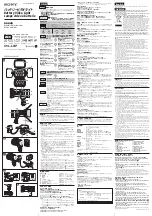
World's First* to Adopt
Micro Four Thirds
The AG-AF100 series is the
first professional HD camera
recorder to adopt the Micro
Four Thirds standards. These standards were
announced in 2008 as an extension of the
Four Thirds standards for DSLR (Digital Single
Lens Reflex) cameras. Panasonic and some
other manufactures have already released a
number of digital cameras and
interchangeable lenses based on the Micro
Fourth Thirds standards.
The "Four Thirds" name is derived from the
4/3-type (approx. 17.3 mm x 13 mm/ approx.
0.68 inches x 0.51 inches) image sensor. The
size of the image sensor, the standardized
lens mount developed for it, and
interchangeable lenses designed exclusively
for digital cameras form the core of the Four
Thirds standards. These standards were
established to offer an optimal solution for
digital cameras, breaking loose the confines
of film camera standards. In establishing the
Micro Four Thirds standards, the flange back
distance (the distance from the lens mount
surface to the image sensor) was reduced by
about half and the mount diameter was made
about 6 mm (0.24 inches) smaller than that of
the Four Thirds mount. The image sensor size
is the same as that of the 4/3 type used in the
Four Thirds standard. The Micro Four Thirds
standards have made it possible to reduce
the size and weight of cameras and lenses,
and to achieve greater interchangeability of
lenses together with video recording
capability.
*1: As of November 2010 (based on a Panasonic survey).
4/3-type MOS Image Sensor
The 4/3-type MOS image sensor in the
AG-AF100 series has about the same
imaging area* as that of 35mm cinema film.
The depth of field and the focal range are
also close to those of film cameras. With the
AG-AF100 series, you can record beautiful,
shallow depth of field, film-like images.
The MOS sensor has two control lines as
compared to the three lines required by a
conventional CMOS sensor, thus providing a
larger light receiving area. This has achieved
a high level of sensitivity rivaling that of a
CCD sensor. Extensive noise reduction
measures are also employed, such as
embedded photodiodes isolated from noise
sources and low-voltage operation. By
guiding more light to the pixels, the
AG-AF100 series achieves a wide dynamic
range and detailed gradation with minimal
blocked shadows or blown highlights in
high-contrast scenes, for true-to-life textures
and rich colors.
* The effective imaging area is trimmed to a 16:9 aspect
ratio.
A Low-Pass Filter for High-Quality
HD Motion Images
The AG-AF100 series' optical low-pass filter
is optimized for HD motion images and
reduces the aliasing noise that often occurs
in motion images captured by an image
sensor with a high pixel density. In addition,
the MOS image sensor is scanned at a high
speed in order to minimize skew distortion.
High-Performance 18-bit DSP
The AG-AF100 series is equipped with a
high-performance 18-bit digital signal
processor (DSP) for image processing.
Optimized for HD video recording, the DSP
handles various image rendering processes,
such as dynamic range stretch
(DRS), gamma, 12-axis
The Camera Section Features a Four Thirds Image Sensor and Design Especially for Video Use, Approaching 35mm Cinematic Expression.
FOUR THIRDS
MICRO
FOUR THIRDS
FOUR THIRDS Flange Back
MICRO FOUR THIRDS Flange Back
Lens Mount
Lens Mount
Image Sensor
35
mm Cinema Film
22 mm (7/8 inches)
16
mm (5/8 inches)
17.3 mm (11/16 inches)
13
mm (1/2 inches)
9.6 mm (3/8 inches)
5.4 mm (3/16 inches)
4/3-type Image Sensor
2/3-type Image Sensor
* N
umerical value shown are approximate.
Receptor ratio 35%
Receptor
Circuit
New Drive
Receptor ratio 50%
Two signal leads
Two signal leads
Thr
ee signal leads
Pixel
Pixel
Pixel
Receptor
Circuit
Receptor ratio 50%
Receptor
Transfer
MOS sensor of AG-AF100 series
CMOS sensor
CCD sensor
Curr
ent Drive
Comparison of Image Sensor Standards


































